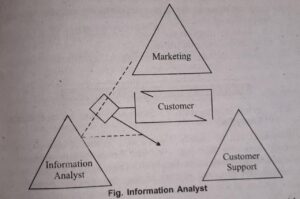
Describe the role of the information analyst and system designer.
Describe the role of the information analyst and system designer.
Ans.
During the course of fulfilling the role of system development, a number of different situations arise, which must be understood to facilitate decisions on the approach, strategy, technology and development. The role of the designer may either be to develop a smaller system or a complex large system. It may also be to design an integrated system, covering all the business systems, requiring their operations on the heterogeneous platform of hardware and software.
At times, the system designer is faced with the problem of developing the additional systems and integrating them with the systems which are in operation already. The third possibility is to change the entire system suitable to meet the current business information needs. The system in use may be old in terms of technology, design and lacks flexibility requiring a higher maintenance cost.
Information Analyst:
An information analyst is responsible for the operation of reporting and analysis software, creating summaries and keeping management informed of trends. Candidates for this position typically have a university or college degree in math, statistics, information technology systems, or business. This type of analyst can find employment opportunities in large companies, reporting software companies, and compliance boards or associations.
People who enjoy working with technology, are focused on details, and can work as a team member report the greatest satisfaction in this role. An information or data analyst must work as part of a team, following the same protocols and processes so that results can be replicated. The role of information analyst is critical to determining the long-term direction of the company and identifying short-term issues that need to be immediately addressed.
The primary role of the information analyst is to run reports and conduct analysis. Within the role of information analyst, some people specialize on a specific type of information. For example, a product development company information analyst might focus on new product development and launch. He or she would gather, evaluate, and track information from a range of sources and use this data to provide an analysis of the areas of strength or weakness in the current strategy. In addition, the analyst can suggest other methods that might be more successful, based on the data.
There is a range of software programs specifically designed for use by information analysts. These programs are often quite complex, requiring specialized skills and training to use properly. Statistical analysis software is also utilized to identify trends and patterns within the data. Keeping up to date on this technology is essential in this role.

Upon completion of the analysis, a written report is provided to management. This report typically includes an executive summary, highlighting the top issues or patterns that require attention, followed by a detailed report. The actual data used to create the report is often attached, along with documentation of the processes used. It is essential that the results can be replicated, as it validates the data and the analysis. In turn, the conclusions can be evaluated for merit, based on accurate information.
System Designer:
System Designer provides a designer surface for designing application systems that are composed from applications defined on the application diagram or systems defined on other system diagrams. One can then progressively design larger and more complex systems by composing them from systems containing other systems. After you design a system, one can evaluate its deployment in the target datacenter.
Systems are composed from applications defined on the application diagram and can include systems defined on other system diagrams in the solution. One can then connect and configure applications independently from their definitions and development configurations for deployment. Being able to reuse a system in another system makes it possible for user to design larger and more complex systems so that one can use them in distributed system scenarios and abstract the details about the members of those systems.
System Designer, does following high-level tasks:
(1) Design a system by adding uses of application and other system definitions as members.
(2) Configure communication pathways between members.
(3) View constraints, settings, endpoints, definitions, and other properties of members.
(4) Override settings on members as needed and overridable on their underlying definitions.
(5) Expose behaviour of members selectively outside the system.






